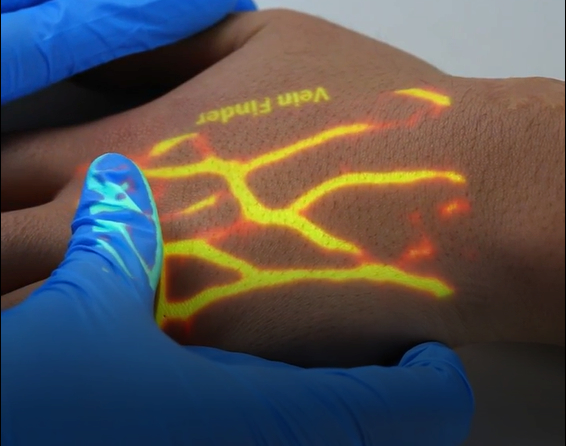1.Venipuncture assistance
Conventional venous puncture、Increase the success rate of puncture
The success rate of traditional puncture (relying on palpation and visual inspection) is approximately 60-75%, while it can be increased to 85-95% after using a vein finder, especially for patients with higher difficulty levels (such as children, the elderly, and obese individuals), the effect is particularly remarkable.
Typical scenarios: blood drawing, intravenous infusion, and placement of indwelling needles.
Reduce complications: Lower the risk of hematoma, nerve damage and infection caused by repeated punctures.
Studies show that after using a vein finder, piercing-related complications are reduced by approximately 40%.
Special patient groups
Pediatric patient
Children's veins are small and mobile, and traditional puncture may require multiple attempts. Vein finder (can clearly display vein branches and reduce the pain of children patients.)
Obese patients
When the subcutaneous fat layer is relatively thick (>3cm), near-infrared technology can penetrate the fat to locate deep veins (the success rate of traditional methods is only 50%).
For patients in shock or dehydration: When blood vessels collapse, the
vein finder can identify veins that are invisible to the naked eye and quickly establish an emergency access.
2. Navigation for surgery and interventional therapy
Vascular surgery assistance
PICC (Peripherally Inserted Central Catheter) :
Accurately select the appropriate vein (such as the precious vein) to avoid mistakenly penetrating arteries or nerves, and the success rate has increased from 75% to over 90%.
Establishment of hemodialysis access: Locate well-functioning veins and prolong the service life of fistulas.
Patients with tumors and undergoing chemotherapy
Protecting vascular resources: Chemotherapy drugs are prone to cause phlebitis. Precise puncture can reduce vascular damage.
3. Emergency and Intensive Care
Rapid establishment of intravenous access: In emergency scenarios (such as cardiopulmonary resuscitation, massive hemorrhage), shorten the puncture time to within one minute.
Difficult intravenous treatment: For burn patients (with skin damage) or those with edema, avoid blind puncture.
4. Management of chronic venous diseases
Varicose vein screening: Evaluate the function of venous valves through dynamic imaging to assist in early diagnosis.
Deep vein thrombosis (DVT) assessment: Some studies have explored the possibility of using a vein finder combined with ultrasound to detect thrombosis (not yet widespread).
5. Special scenario applications
Military and disaster medicine
Battlefield first aid: Portable devices can quickly locate veins in low-light or harsh environments.
Veterinary field
Pet medical care: It is used for venipuncture of animals such as dogs and cats, especially for small dogs or dehydrated animals, with remarkable effects.
6. Medical Education and Quality Control
Training and teaching: Demonstrate the anatomical structure of veins through real-time imaging to reduce the practice mistakes of beginners on real patients.
Operation Record and analysis: Store puncture data for review to enhance the technical proficiency of the team.
Clinical advantages and limitations
Advantages
Non-invasive, real-time imaging
Reduce medical costs (decrease waste of consumables and repetitive operations)
Improve patient experience (reduce pain and anxiety)
Limitations: Technical limitations: The efficacy may decline for patients with extreme obesity (fat layer >5cm) or severe circulatory disorders.
The future direction of clinical development
Fusion with ultrasound: Enhance the imaging capability of deep veins and microvessels.
AI prediction system: Automatically recommend the best puncture path.
Low-cost popularization: Develop a simple version suitable for primary healthcare.

Vein finder has gradually evolved from an "optional tool" to a "clinical necessity", especially showing significant value in enhancing medical safety and efficiency. However, its full-scale popularization still needs to address issues of cost and technical compatibility.
Also welcome to contact us, we are ZD Medical Inc.
Tel : +86-187 9586 9515
Email : sales@zd-med.com
Whatsapp/Mobile : +86-187 9586 9515
